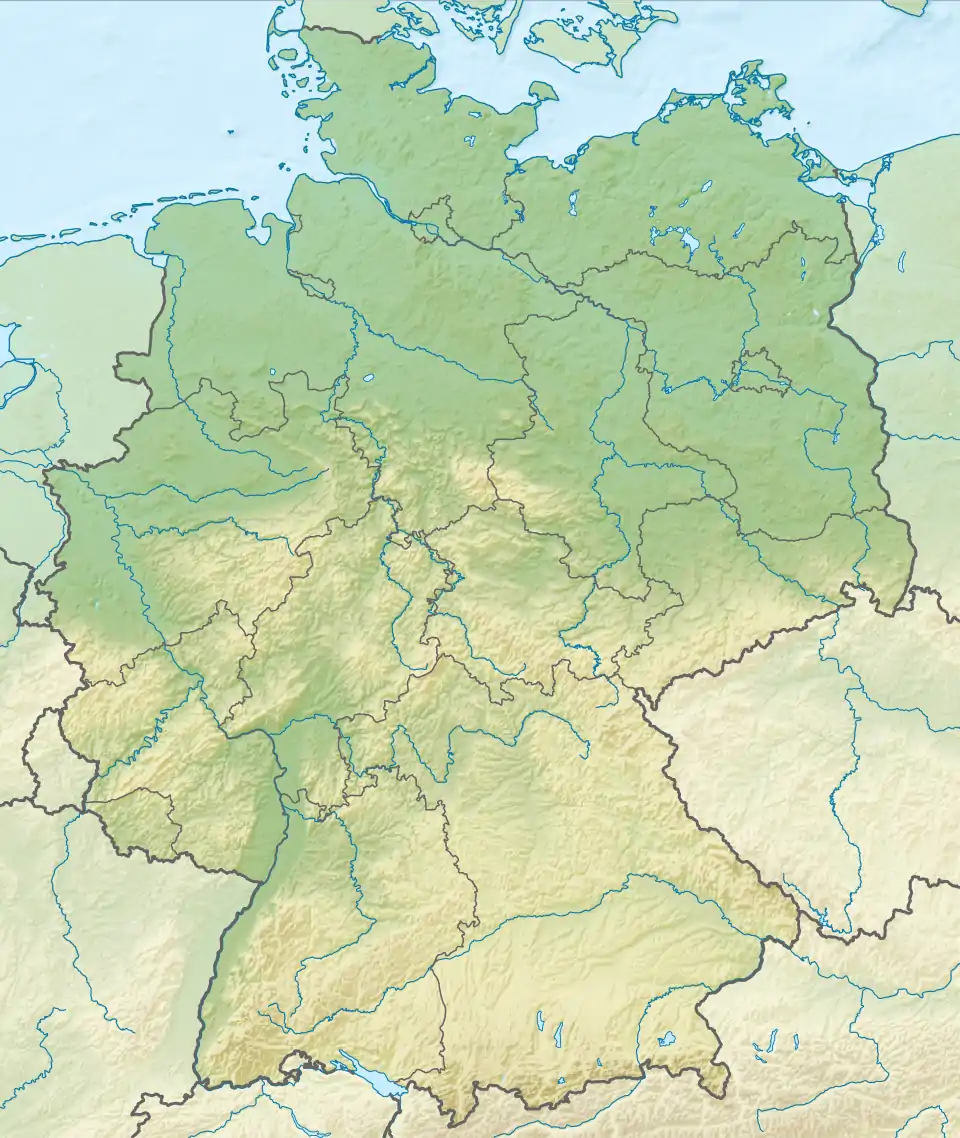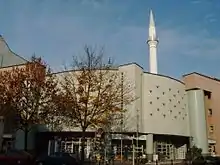| Red Mosque (Schwetzingen) | |
|---|---|
German: Rote Moschee | |
 | |
| Religion | |
| Affiliation | Islam |
| Branch/tradition | Sunni |
| Location | |
| Location | Schwetzingen, Germany |
 Shown within Germany | |
| Geographic coordinates | 49°23′01″N 8°33′57″E / 49.38361°N 8.56583°E |
| Architecture | |
| Architect(s) | Nicolas de Pigage |
| Type | mosque |
| Style | Turkish |
| Groundbreaking | 1779-1793 |
Red Mosque (German: Rote Moschee (also known as "Mosque in Schwetzingen Palace Garden") is the oldest Turkish-style mosque in Germany. Built in 1779–1793, located in the southern part of the Schwetzinger Park.
History
The Red Mosque was built by the French architect Nicolas de Pigage on the order of the electora Palatinate. It was built on the territory of the Schwetzingen Palace in the Turkish style. The first stage of construction was the Turkish Garden (French: Jardin Turc) in 1776. The construction of the mosque began in 1779 and was completed in 1792–1793, while the minarets were completed only in 1795–1796. The cost was about 120,000 guilders, making the mosque the most expensive building in the gardens. At the time construction began, the court had already moved to Munich because Karl Theodor had become Elector of Palatinate-Bavaria in 1778. The structure did not have the function of an Islamic prayer house but was intended, following the enlightened general concept of the Schwetzingen palace gardens, to express tolerance for all religions and cultures of the world.
Although the building lacks some elements typical of a mosque, it was used for Islamic worship from time to time, such as after the Franco-Prussian War of 1870—1871, when prisoners of war from the Maghrib were housed in military hospitals near Schwetzingen, as well in the 1980s. Since 1970, the entire Schwetzingen palace complex has been reconstructed in accordance with the park maintenance plan. The restoration of the mosque began in the 1990s and was completed in 2007. The state of Baden-Württemberg has invested about 2.5 million euros to renovate the exterior of the mosque, 6 million euros to renovate the prayer aisles and 1.5 million euros to the interior.[1]
Architecture
The dome of the mosque resembles the Christian dome of St Paul's Cathedral in London, but the pulpit, altar and font are missing. The interior of the domes are dominated by stars, a common symbol of Islam. The style of the building is attributed to the so-called Turkish fashion. Although it looks like a mosque, it differs from a «real» mosque in some respects: it usually has an enclosed courtyard, towards which the facade is also drawn, and on the outside it is simply processed. This is not the case in Schwetzingen. In addition, the Schwetzingen Mosque has a gallery, the counterpart of which can be found in the cloister of a Christian monastery, and a dome that imitates St. Paul's Cathedral in London. In the courtyard there are fountains for ritual cleansing before prayer (ablution); the interior includes a pulpit and a niche indicating the direction to Mecca (Qibla). The overall impression of the dome, portico and free-standing towers is most reminiscent of the cathedral Karlskirche in Vienna. The mosque, with a ceiling decorated with stars, represents the night and the sky in a spiritual and spiritual sense, and at the same time is a symbol of life after death.[2]
Gallery
 Pond next to the mosque
Pond next to the mosque Mosque portal, side view
Mosque portal, side view The courtyard of the mosque with the main entrance and corner buildings in the Schwetzingen palace garden
The courtyard of the mosque with the main entrance and corner buildings in the Schwetzingen palace garden The walls of the main hall are decorated with ornaments, inscriptions sayings from the Koran
The walls of the main hall are decorated with ornaments, inscriptions sayings from the Koran Summer Gallery
Summer Gallery Decorative arches of the summer gallery
Decorative arches of the summer gallery Entrance to the summer courtyard of the mosque from the other side
Entrance to the summer courtyard of the mosque from the other side Upper part of the minaret
Upper part of the minaret
See also
References
- ↑ Kirsten Baumbusch: Tempel des Geistes erstrahlt in frischem Rosé – Orientalisches Ambiente im Schwetzinger Schlosspark. In: Rhein-Neckar-Zeitung, 19. July 2023.
- ↑ Jan A.M. Snoek: Schwetzingen: more than just a masonic garden. In: Joannes A. M. Snoek (Hrsg.): Symbolism in 18th century gardens: the influence of intellectual and esoteric currents, such as freemasonry. Den Haag 2006, ISBN 90-807778-3-8, S. 149–187 (esswe.org).
Further reading
- Carl-Ludwig Fuchs, Claus Reisinger: Schloss und Garten zu Schwetzingen. Werner, Worms 2001, ISBN 3-88462-164-5.
- Wiltrud Heber: Die Arbeiten des Nicolas de Pigage in den ehemals kurpfälzischen Residenzen Mannheim und Schwetzingen. Werner, Worms 1986, ISBN 3-88462-909-3, Manuskripte zur Kunstwissenschaft in der Wernerschen Verlagsgesellschaft 10, (Zugleich: Heidelberg, Univ., Diss., 1977).
- Jörg Gamer: Bemerkungen zum Garten der kurfürstlich-pfälzischen Sommerresidenz Schwetzingen in Carl Theodor und Elisabeth Auguste Höfische Kunst und Kultur in der Kurpfalz Ausstellungskatalog für das Kurpfälzische Museum Hrsg. Jörn Bahms unter der Schirmherrschaft des Heidelberger OB Rheinhold Zundel (Erscheinungsjahr 1979), S. 20–25.
- Franz Schwaab: Die grosse Moschee zu Mekka in Arabien und deren Nachbildung, die Moschee im Schwezinger Garten. Schwetzingen ca. 1895 (Digitalisat).
External links
![]() Media related to Moschee Schwetzingen at Wikimedia Commons
Media related to Moschee Schwetzingen at Wikimedia Commons
- Offizielle Website zur Moschee im Schwetzinger Schlossgarten
- Landeskunde online: Die Moschee im Schwetzinger Schlossgarten

